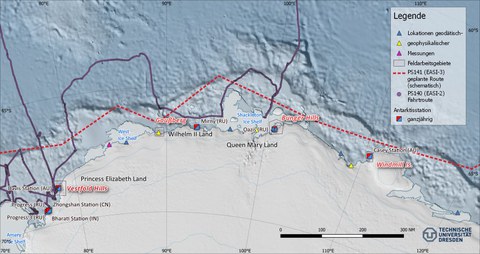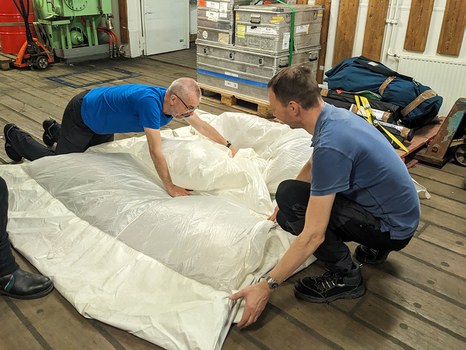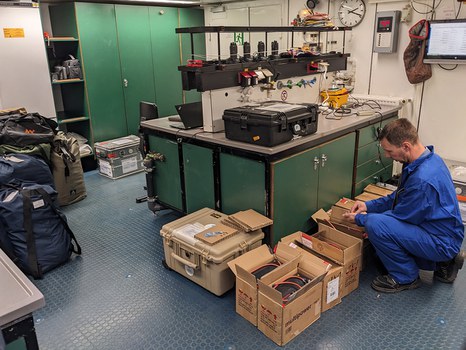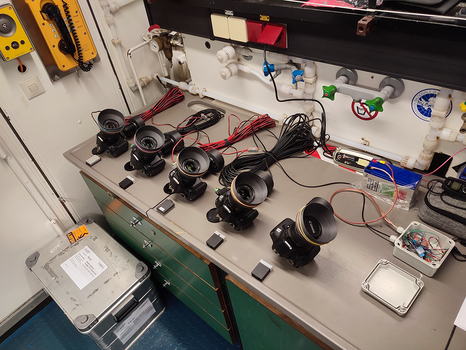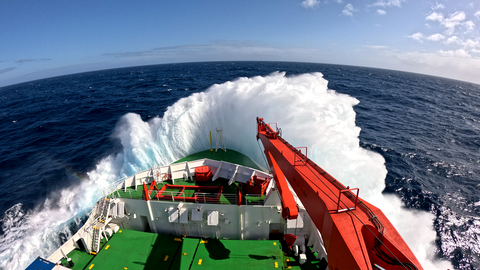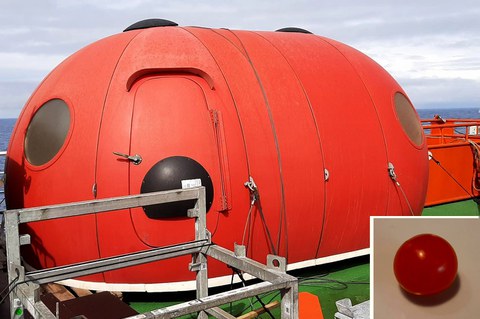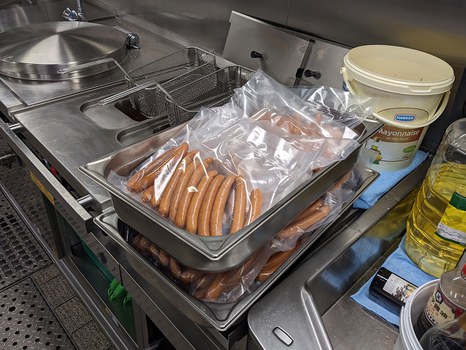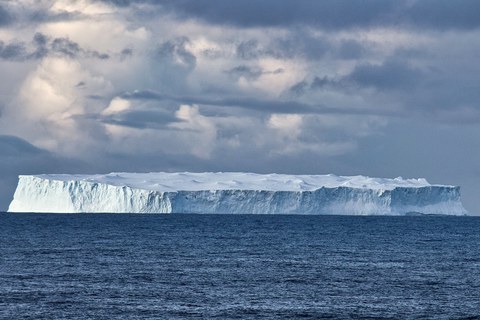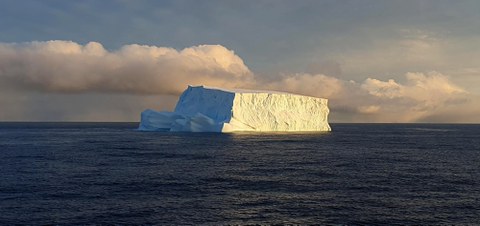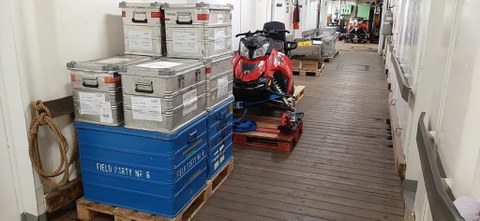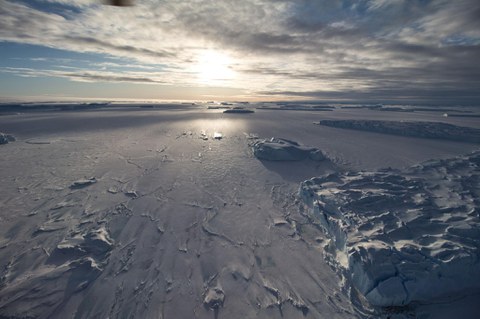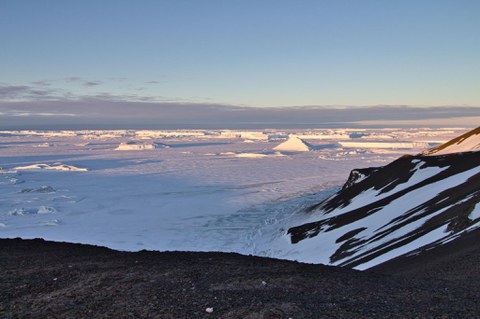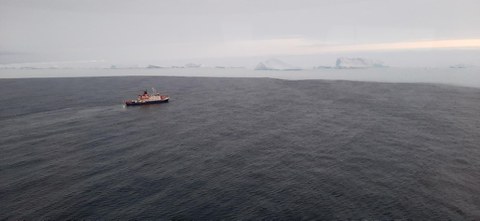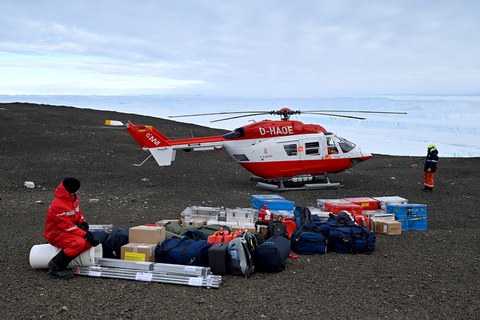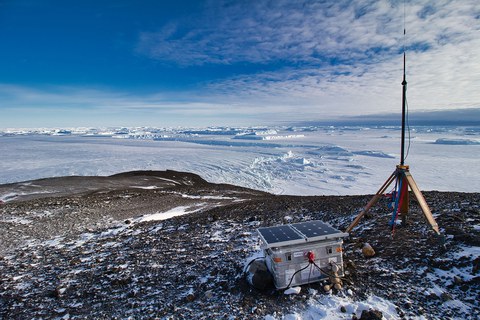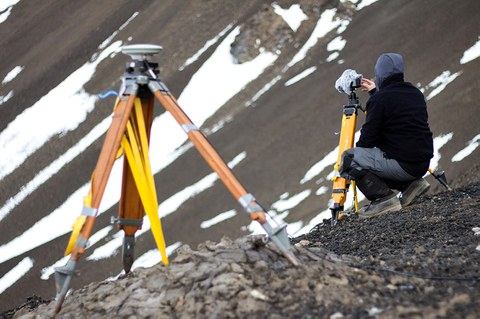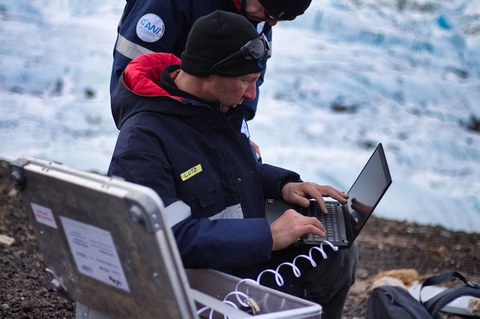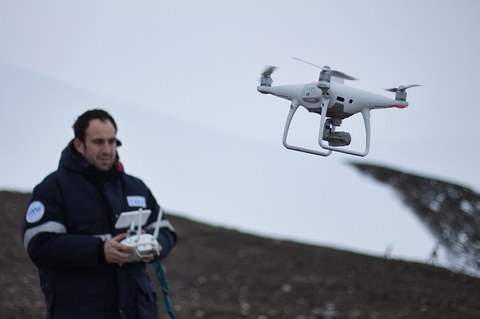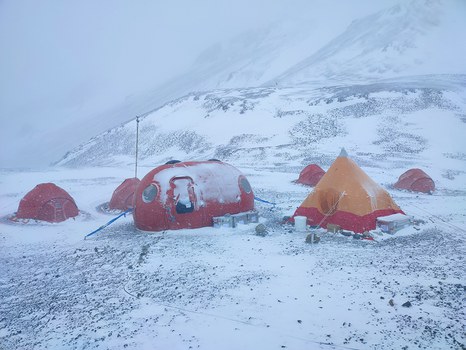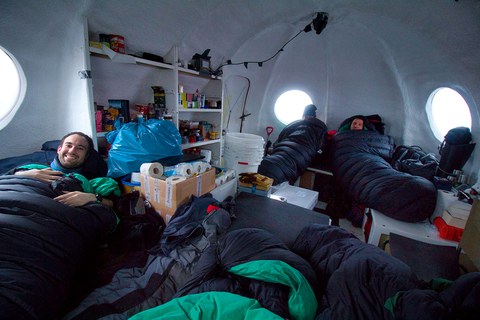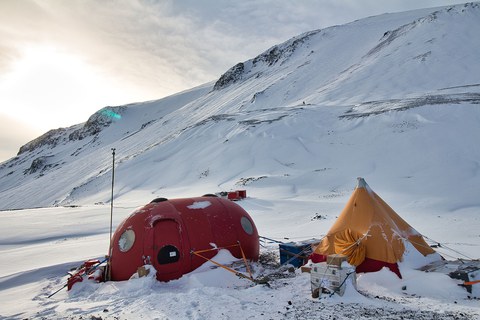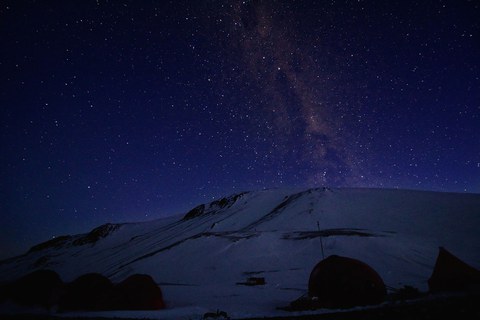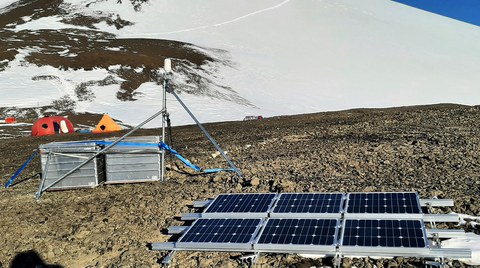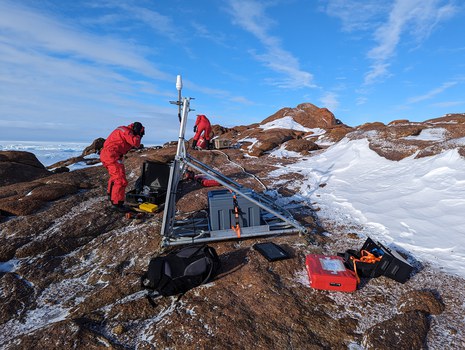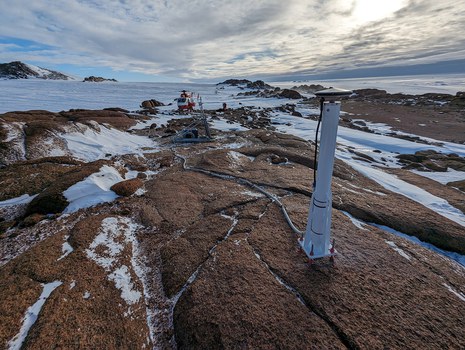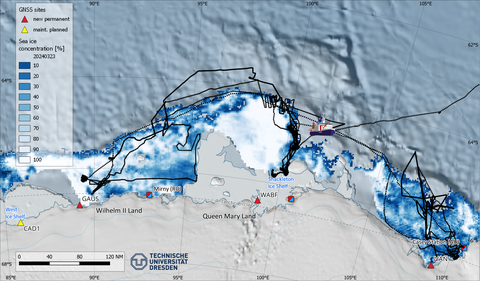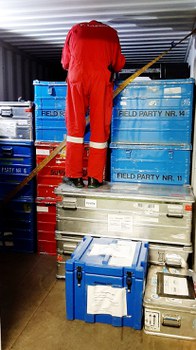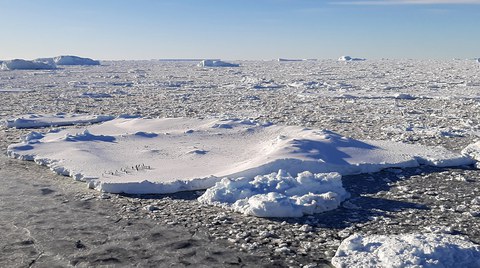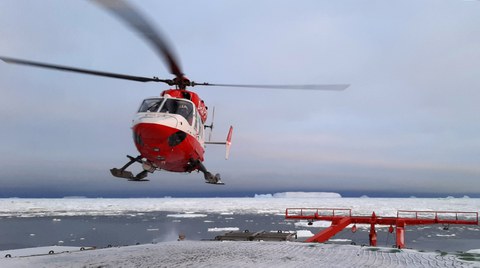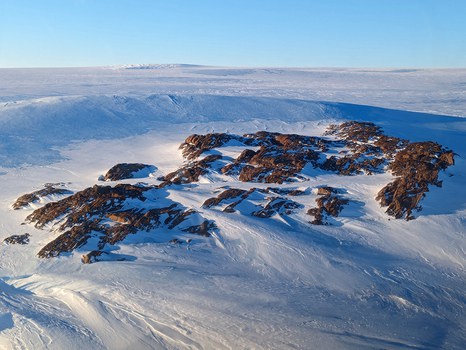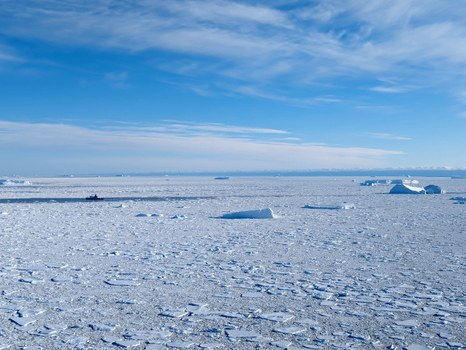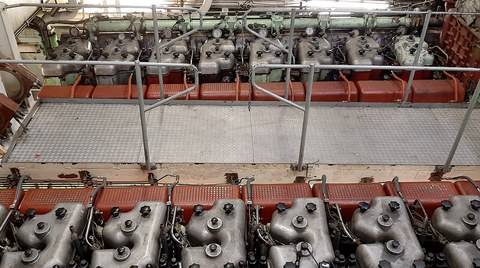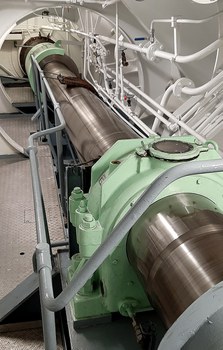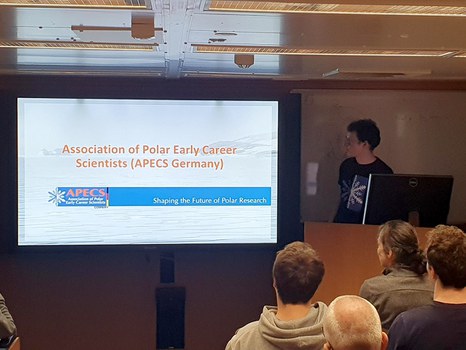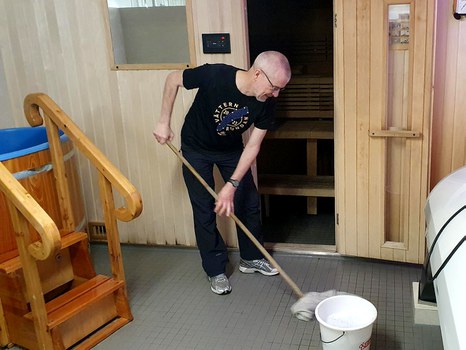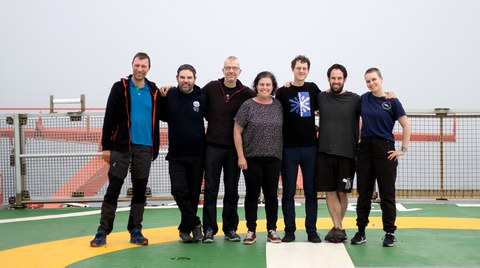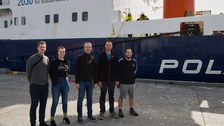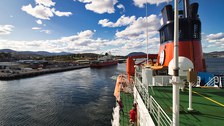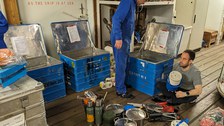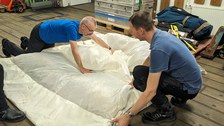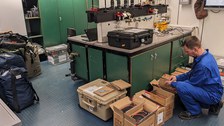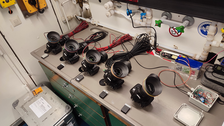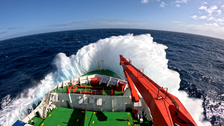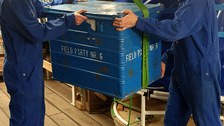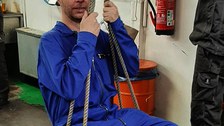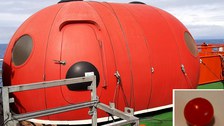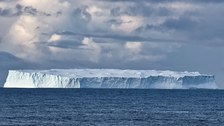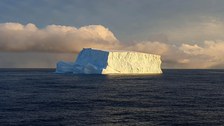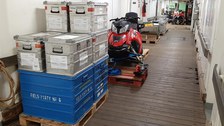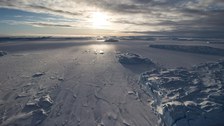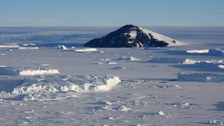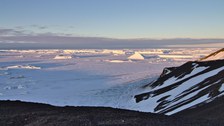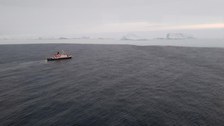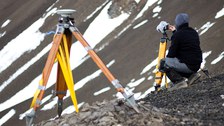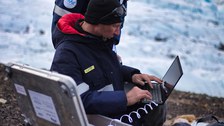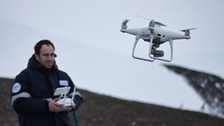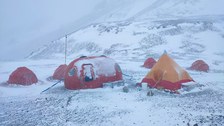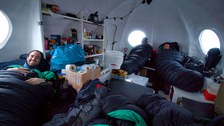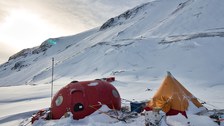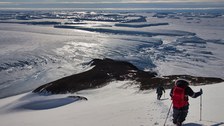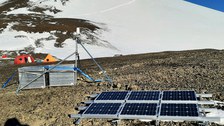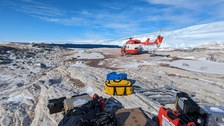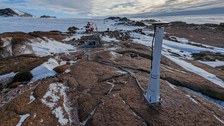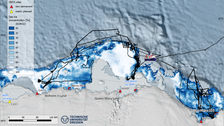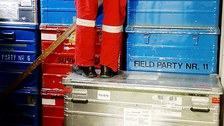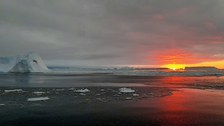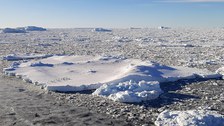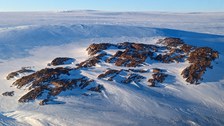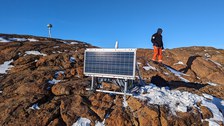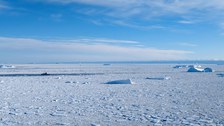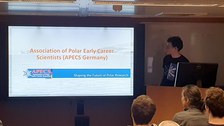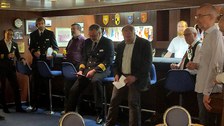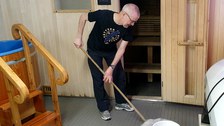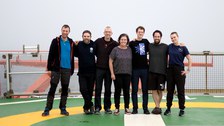Polarstern PS141 EASI-3
The expedition PS141 EASI-3 is the consortium's third research expedition with the “Polarstern” since 2022. The TU Dresden research group, led by Dr. Mirko Scheinert, is currently supported by two Australian scientists and will focus primarily on geodetic-geophysical measurements in East Antarctica’s outer area. Using measurements from global navigation satellite systems (GNSS), the team aims to record the movement of the Earth's crust with the utmost precision, revealing its reaction to past and present changes in ice mass. Together with geophysical measurements, the data should contribute to a better understanding of the deformation and internal structure of the Earth in the East Antarctic region
A special challenge awaits the researchers on Gaussberg, where they are planning a field camp on land for several weeks. Gaussberg is an extinct volcano that erupted under the Antarctic ice around 56,000 years ago. It was discovered in March 1902 during the first German South Polar expedition led by Erich von Drygalski. Following in their footsteps, the scientists want to conduct a new survey of the area today. In addition to modern geodetic methods and drone photogrammetry, they will use geophysical measurements and detailed geological sampling.
We (Lutz Eberlein, Marie Weber, Mirko Scheinert, Xabier Blanch Gorriz, and Erik Loebel) are finally on our way! In view of the long lead time - the first ideas and applications for a Polarstern project in East Antarctica with a considerable amount of land-based work go back more than ten years, the actual preparations began about a year ago - the start of the cruise is an long-time awaited, joyful event.
As this was the first time Polarstern had ever called at a port in Australia, AWI, together with the German Embassy and Australian partners, had organised a programme that was expressly aimed at the public. Further details can be found here:
The Polarstern cruise PS141 is the third cruise of the multidisciplinary EASI project. EASI stands for "East Antarctic Ice Sheet Instabilities". This project, in which Mirko is a co-applicant, aims to reconstruct the development of the climate and the ice sheet in East Antarctica. The aim is to better understand the mechanisms that influence the current state and further development of the ice sheet which can be affected by possible instabilities. The interactions of the ice sheet with the Southern Ocean, the solid Earth and the atmosphere are particularly crucial here. The EASI consortium has acquired three projects for the utilisation of the research platform "Polarstern". The first cruise PS128 (EASI-1) took place at the beginning of 2022. The research cruise PS140 (EASI-2) started on 25 November 2023 in Cape Town (South Africa) and ended on 1 February 2024 in Hobart (Tasmania, Australia).
We boarded for the third voyage PS141 (EASI-3) on 5 and 6 February. We - that's Lutz, Erik and Mirko from the Chair of Geodetic Earth System Research, Xabier from the Chair of Geosensor Systems and Marie as a Bachelor's student of Geodesy and Geoinformation. Jodi and Jack from our Australian co-operation partner University of Tasmania (UTAS) complete our team.
We will concentrate on geodetic-geophysical measurements in the coastal area of East Antarctica. To this end, geodetic GNSS (Global Navigation Satellite Systems) measurements already initiated by UTAS will be continued and new permanent GNSS stations will be set up on bedrock. Using GNSS, we will precisely measure the displacement of the Earth's crust, which is caused by past and present ice-mass changes. Geophysical measurements in co-location with GNSS (especially magnetotellurics) will provide valuable data to quantify the internal structure of the Earth in the East Antarctic region. A special challenge awaits us at Gaussberg, where a field camp on land lasting several weeks is planned. The Gaussberg, a volcano that erupted subglacially around 56,000 years ago, was discovered in March 1902 - almost exactly 122 years ago - by the 1st German South Polar Expedition led by Erich von Drygalski. Following in the footsteps of the Drygalski expedition, we plan to carry out a new survey using modern geodetic and UAV-supported photogrammetric methods. The Gaussberg programme will be supplemented by geophysical measurements and detailed geological sampling.
Polarstern set sail from the pier near the city centre in Hobart on 6 February 2024. We travelled south across the Derwent River and past Bruny Island into the open ocean. Anyone following the ship's route on https://follow-polarstern.awi.de will already have seen that after initially heading west, we have been on a south-westerly course towards Antarctica since Thursday. The exact course depends on the planned programme - after all, marine geological and oceanographic investigations form a significant part of it - and of course on the current weather.
As we are planning extensive work on land - Jodi, Lutz, Xabier, Erik and Mirko in the field camp at Gaussberg, Marie will accompany the group from the University of Cologne during field work in the Bunger Oasis, and Jack will visit further measuring stations on land from the ship - the days since leaving Hobart have been filled with work to sort, check and prepare the scientific instruments and technical equipment as well as the equipment for the planned field camp. This includes GNSS receivers, cameras, lots of batteries, satellite phones, polar clothing, tents, boxes of kitchen equipment (so-called field party), generators, and much more...
By now, we have all familiarised ourselves with life on board, rarely get lost and only occasionally have to contend with symptoms of seasickness, which of course have not yet completely disappeared at the intersection of the "roaring forties" and "furious fifties"...
So we are all in good mood and are eagerly awaiting our arrival in Antarctica.
We spent the week that has just ended organising and preparing our equipment. This included weighing most of the individual items so that we can prepare the payload for the helicopter transport in such a way that the total load would not be exceeded. Weighing is also done - usually on Sundays - by anyone who wants to at the "weighing club", where you have to predict how your own weight will develop over the next week. With the excellent catering on board, it is quite a challenge to maintain your weight. Catering is the next keyword, as we also had to sort the food we had ordered and brought on board in Bremerhaven into smaller packages. Vienna sausages, originally delivered in jars and not suitable for use in the field, found their way into new, space-saving, evacuated packaging thanks to the great help from the kitchen. Tomatoes are normally part of the meal - but not for our planned field camp. Nevertheless, we will have a "tomato" with us - a transportable, stable cabin made of fibreglass composite that will hopefully serve us well in the field camp, especially in bad weather (because it will give shelter for strong winds and storms). We also tested the mountaineering equipment and repeated its handling. Several days of mountain, glacier and safety training were part of our preparations back in 2023.
There were quite some responses to the press release issued by TU Dresden on the day Polarstern left Hobart. The radio station "MDR Aktuell - das Nachrichtenradio" conducted an interview with Mirko on 13 February 2024, which was broadcast in the morning programme (9:48 and 11:48). The interview can still be listened to up to and including Monday (19 February 2024) at: https://www.mdr.de/mdr-aktuell-nachrichtenradio/audio/index.html#20240213_9-12. If you want, you can find out the two mistakes in the title... An article based on the information given by the press release and an email communication with Mirko was published in the "Dresdner Neueste Nachrichten" on 17 February 2024.
It is a good tradition that the scientific programme of the individual groups is presented in short talks. Mirko was able to do this for our group on Wednesday, as well as explaining the historical background of the 1st German South Polar Expedition led by Erich von Drygalski with a further presentation.
On Friday morning, the first icebergs were finally sighted at approx. 59°40' South, and on Saturday night (approx. 2 a.m. ship time) the 60th parallel South was crossed. Since then we have been in the area of the Antarctic Treaty and are now on course for the Antarctic continental margin at approx. 65°50' South and 100° East.
With best wishes from aboard Polarstern!
This time it will only be a short report.
On Monday, the first field work group was deployed in the area of the Bunger Oasis. There, the group from the University of Cologne, which also includes an Australian colleague and our student from Dresden, Marie Weber, will take geological samples and carry out geologic-geomorphological investigations. Polarstern then took a north-westerly and westerly course, during which mainly seismic measurements were carried out, and finally headed towards Gaussberg. Early on Saturday (24 February 2024) evening, we arrived at the sea ice edge north of the Gaussberg, at a distance of approx. 30 nautical miles (= approx. 55 km). We had already sorted our cargo and prepared it for the individual flights on the working deck. After a short reconnaissance flight, two more flights to the Gaussberg could be realised to transport cargo there. Erik and Mirko took part in this, but returned to the ship with the second flight. Tomorrow, Sunday, it is planned to fly the rest of the cargo and all five of us (Jodi, Xabier, Erik, Lutz and Mirko) to Gaussberg. Thus, we will start our field camp tomorrow. I guess that our stay will last at least three weeks. We will only be able to send short messages sporadically during this time.
We are looking forward to the field campaign at Gaussberg with excitement, and send our warmest greetings for the next few weeks from aboard Polarstern!
On Sunday (25 Feb) the alarm clock rang at 4.00 a.m., at 4.30 a.m. I attended the short weather briefing, and shortly after 5.00 a.m. the helicopter started to its first of seven further transport flights to Gaussberg, with Erik and Mirko being aboard. Together with the helicopter technician we remained at location in order to receive the freight coming with the further flights. Altogether, our freight comprised 4.2 Tons, us five included. Besides the scientific equipment there was a lot of stuff for the field camp, among others the aforementioned “tomato” as well as two snowmobiles (of the make Lynx). About 1.30 p.m., after the last transport flight was accomplished, the helicopter left us taking course towards the ship – we five have been arrived at Gaussberg.
During the second half of this Sunday we dealt with the set-up of the field camp. This includes two Scott tents (shaped like a cone with four very solid poles, in which one can stand upright without any problem especially since we removed the inner tent), five sleeping tents of geodetic design, and the “tomato”, of course. About 9.30 p.m. we went into our tents, being tired and exhausted from this day.
On Monday (26 Feb) we further dealt with the organisation of our field camp, in order to stow everything at a suitable place outside or inside the tents. In the afternoon, at a first walk we explored the plateau where our field camp has been established, at the north-western side of Gaussberg. At the most western point of this plateau, in an altitude being about 40 m lower, one arrives at Cape Lewald. There, we could identify one of the mountain points of the Drygalski expedition (namely point A), given the pile of erratic rocks (which were transported by the ice and did not originate from Gaussberg).
On Tuesday (27 Feb) morning, up to now we had the lowest temperature with -14°C. After the wind has weakened we could begin with setting up the first devices. In a distance of about 150 m from the field camp we put four tripods, with a westward view onto the glacier. There, on Wednesday (28 Feb) Xabier mounted cameras to take regular shots to infer the motion of the glacier. Jodi explored the terrain from a geologic point of view and took first volcanic rock samples. In the afternoon, Lutz, Erik and Mirko visited the two snowmobiles which were placed at the ice surface at the edge of Gaussberg about 600 m south of the camp. Both snowmobiles could be started immediately, so that they are ready to use. On the way to the snowmobiles we made a ‘detour’ to a smaller ice-free plateau about 400 m south of the field camp, where a further mountain point (point B) should have been found. There, it was more difficult to identify the correct pile of rocks since much less erratics occur. However, evidence is given by the relevant views to point A and towards the ice surface. Finally, we established two further devices, one GNSS and one camera, both with a direct sight towards the ocean bay at the northern edge of Gaussberg. Realizing this experiment we intend to determine the change of the (ice-covered) surface of the sea.
On the following days (Wednesday to Friday) the weather only allowed us to work some hours. Xabier checked the cameras, supported by Erik; Jodi took further geological samples. Lutz and I checked the GNSS campaign station which was set up by our colleague Benjamin during the previous cruise PS140. Due to a technical problem we had to change the receiver. About 100 m away from the field camp we started to mount the pillar which should carry the antenna for the new permanent GNSS station. Furthermore, first test flights of the two UAV (unmanned arial vehicles) could be performed by Xabier and by Lutz. However, both flights had a short duration due to the variable wind conditions.
On Saturday (2 March) – which has been an especially memorable birthday for Mirko, and which glasses have been clinked to in a good mood – the weather further deteriorated. Snowfall added its share, such that we could not think of doing any work outside. Only a further check of the cameras could be accomplished.
On Sunday (3 March) Gaussberg and, thus, also our field camp got completely into the influence of a low pressure system. As a precaution we turned off all sleeping tents as well as one Scott tent. The second Scott tent as well as the “tomato” were checked and secured. Since then, the “tomato” has been serving us as a safe accommodation. Here we are persevering until the storm low will have been passed away.
Eventually, on Thursday (7 March) the influence of the deep pressure system weakened to such a grade that we could start with our fieldwork again. After the snowfall stopped (and the storm has partially blown it away again) this day became a wonderful one – almost no wind and temperatures close to zero.
This Thursday has been the first nice day since the two or three good days at the beginning of our field camp at Gaussberg. We were able to check the equipment and set-up devices, carry out more UAV flights, take geological samples and get our field camp in shape: Erik and Xabier are able to set up three of the five sleeping tents again. Since then, Erik, Xabier and Lutz have been sleeping in the tents again, while Jodi and I continue to sleep in the "tomato".
The next few days are characterised by the fact that we have to wait in the mornings until the wind has calmed down to a wind speed well below 10 m/s. Otherwise, the wind chill effect means that working outside is not possible for long: at -15°C and a wind speed of 10 m/s, the noticeable temperature is -27°C. The almost continuous cloud cover also makes for rather grey days; hardly any structures can be seen on the ice.
This means that the work is limited to a few hours. On Friday (8 March), we were able to add a radio modem to the GNSS campaign station so that it can send correction data as a reference station. This correction data is received by the mobile GNSS equipment (the so-called "rover"); in this way, the coordinate accuracy of the point to be determined reaches a few centimetres within a few minutes (the procedure is called "Real Time Kinematic" (RTK)). Using RTK, we measure the positions of the four cameras pointing at the glacier as well as point A of the Drygalski expedition, which is located at the western end of the plateau at Cape Lewald.
In the days that followed, another main task was to set up the new GNSS permanent station. The successful realisation of this work is mainly due to Lutz. However, based on the experience of the storm, we decided to modify the design to better suit the conditions: The six solar panels are mounted close to the ground (and not vertically), and in the immediate vicinity are the two Zarges boxes, which house two sets of three 100Ah batteries as well as the receiver, modem for satellite communication (Iridium) and other electronics. These two boxes are also mounted directly on the ground and are stabilised by a tubular steel construction. The construction also accommodates the Iridium antenna. The pillar with the GNSS antenna is located approx. 30 metres away.
It wasn't until Sunday (10 March) that we were able to enjoy another sunny day, although the wind was still up to 10 m/s by noon. Further 'mountain tours' took us to a smaller plateau south of our camp, where we measured Drygalski point B using RTK. After Jodi, Xabier and Erik had returned from this short tour and we had taken a lunch break, Mirko joined us to descend first. The bay where the Drygalski expedition had set up camp in April/May and September/October 1902 is located on the north side of the plateau with our camp. A little further on we climbed uphill again to reach the North Cape and Drygalski Point N1. Both locations (B and North Cape) were geologically sampled by Jodi, and on the following Monday (11 March) she was able to extend the sampling to the area of the bay mentioned and the areas below Cape Lewald. In the afternoon, we set up the GNSS station again directly above the bay, which is to determine the change in sea level using the GNSS reflectometry method. This station was affected by the storm on 3 March and had not recorded any data since then.
After working in the area of the field camp (GNSS permanent station, cameras), the windy to stormy weather prevents us from doing any further work for half of Tuesday (12 March) (from noon) and the whole of Wednesday (13 March). Again, we had to be patient... At least I can calculate a first Helmert transformation on my laptop with the three Drygalski points (A, B and N1) determined using RTK in order to transfer all the points determined by Drygalski on the Gaussberg and on the glacier from the local to a georeferenced system. The weather only improves over the course of Thursday (14 March), until there is almost no wind in the afternoon – an extremely rare situation on the Gaussberg. This allows Xabier to realise further UAV flights over the adjacent glacier to the west and the northern bay.
In the meantime, Polarstern's plans had become so concrete that our pick-up from Gaussberg was planned for the weekend (16/17 March), taking into account the medium-term weather forecast and sea ice conditions. So Friday (15 March) was our last day of fieldwork. This time we were lucky with the weather: after an early morning temperature of -10°C, the sun came around the mountain and ensured good conditions. In view of the "clean-up" work required due to the early pick-up, I decided to organise the day in two groups: Jodi, Erik and Xabier headed up to the summit of the Gaussberg shortly after 11am, while Lutz and I dismantled the GNSS station for the ocean observation, and started sorting the equipment for transport. The three "summiters" were very successful: in addition to another five Drygalski points measured by RTK, Jodi extended the geological sampling of volcanic and erratic rocks to the summit area. Xabier was also able to realise another UAV flight from the summit, for just under 20 minutes due to the wind conditions. After about 4.5 hours, the three of them returned. In the evening, we dismantled the GNSS campaign station with the radio modem, as the RTK measurements had been completed.
In glorious weather, we were able to observe at the bay how high tide caused tidal crevasses to form in the sea ice. Partially accumulated seawater formed small lakes in the immediate shore area. And suddenly three Adelie penguins could be seen on the beach, the only creatures visible to us apart from the ever-present skuas (big predatory seabirds) and seals in the distance.
On Saturday (16 March) it was time to say goodbye to the Gaussberg. In the morning we finalised the tidying up, the tents were dismantled and packed up, and everything was prepared for transport. At around 12 noon, the helicopter landed for the first time to make its way back to Polarstern fully loaded. We landed on the heli deck of Polarstern at around 7.15 pm after the last flight of the Saturday – all the equipment (except for the two snowmobiles) and the five of us were back on the ship. The two snowmobiles were brought in this Sunday (17 March), which gave Xabier the opportunity to take further photographs from the helicopter, which will be used in conjunction with the UAV images to derive a 3D terrain model.
After these three extremely exciting but also exhausting weeks at Gaussberg, we were of course happy to enjoy a warm shower and sleep in a cosy bed... It's still too early to draw final conclusions, but the most important thing is that after this time all five of us – Jodi, Erik, Xabier, Lutz and Mirko – were able to return to the ship in good health.
The Gaussberg was pretty tough on us, or rather the three weeks in the field camp. It took some time to recover properly. But there was still some work to be done, especially sorting out the equipment and putting everything in the right place. The tents and sleeping bags had to be spread out to air out and dry. The large boxes with the kitchen equipment ('Field Party') and the emergency boxes ('Survival Bag') had to be packed again according to the packing lists, as did the mountain equipment. All the boxes have to be labelled for the return transport so that the cargo can be allocated to the appropriate groups once Polarstern arrives in Bremerhaven. Finally, our own scientific equipment has to be stowed away. This work will keep us busy for part of the coming week.
Nevertheless, from a geodetic point of view, we can report on further successful fieldwork. Jack Beardsley, our colleague from the University of Tasmania (UTAS), was not at Gaussberg, but stayed on board the entire time. His programme included visiting other locations on land as far as possible in order to maintain existing GNSS installations of UTAS, and to set up new permanent GNSS stations. Already on 5 March 2024, he was able to visit Ivanoff Head, about 90 km southwest of the Australian station Casey. The strong winds made the work difficult, but a new permanent station was successfully set up. Last Thursday (21 March 2024), the weather was not at its best either, but the ship was close to the Bunger Oasis and within flying distance of another location, Watson Bluff. With the help of Marie, our student from Dresden, and an Australian colleague, Jack was able to set up another new GNSS permanent station. Here, the conditions were rather difficult too, as the strong wind created a corresponding wind chill effect. In total, the three of them travelled for around 5 ½ hours, returning exhausted but happy with their success.
The attached overview map shows the section of East Antarctica where Polarstern is travelling, the route already travelled is plotted by black lines and dots. The position of Polarstern as of late noon local time today is marked. The three new permanent GNSS stations are marked by red triangles – Gaussberg (GAUS), Watson Bluff (WABF) and Ivanoff Head (IVAN). The direct distance between Gaussberg and Ivanoff Head is approximately 870 kilometres. It is noteworthy that these two stations are the only measuring stations during PS141 that are located south of the Antarctic Circle. In addition, the extent and concentration of sea ice cover from yesterday Saturday (23 March 2024) is shown – we can already observe considerable new sea ice formation.
The weather conditions remained difficult. On Monday (25 March), Polarstern was located north-east of the Bunger Hills. A marine geological station was on the agenda, but this had to be cancelled due to the swell. Throughout the time wind speeds reached values of 50 to 60 knots. During the night to Tuesday, it was attempted to set a favourable course so that the effects of the storm would not be felt too severely. From Tuesday morning, the ship set a westerly course.
We stowed the rest of our equipment in the Zarges boxes, and the remaining package items were labelled with our home address. On Wednesday (27 March), our equipment was stowed in the container together with the equipment for the field camps. Lists also have to be kept and entered into a central system so that we can finally pick up our cargo in Bremerhaven after Polarstern will have arrived in mid-May 2024, and will have been unloaded.
Thursday (28 March) was our last day in the ice, it promised to be a sunny day. This was heralded by a marvellous sunrise. There was also a further opportunity for Jack to fly by helicopter to a GNSS point – this was actually the last scientific helicopter flight of the cruise. This time he went to Carey Nunatak (abbreviation CAD1 – see map from last week's report), about 150 kilometres west of Gaussberg on the coast of Antarctica. Jack was able to carry out maintenance of the GNSS station there, and some of the equipment, such as the receiver, was replaced. This visit was also very successful, as it had not been possible to reach the measuring point since the 2016/2017 season. Back on the ship, an initial inspection revealed that the station had recorded data almost continuously, i.e. for a period of more than seven years.
Polarstern has now been on the long transit towards Walvis Bay since Thursday afternoon. Initially on a westerly course, the ship has been heading north-west since Sunday (31 March) evening. Stormy winds and corresponding swell will be our companions for the time being.
The Polarstern expedition is slowly but inexorably coming to an end. We have already completed a considerable part of the return journey, but still have about 1,300 nautical miles (= 2,400 kilometres) ahead of us (as of this Sunday evening).
A large part of the past week was spent working on the reports. The cruise report, in which the measurements and sampling are to be documented in detail, is particularly worth mentioning here.
Whereas during the stay in Antarctica, short meetings were held every day at 19:30 to report on the current day and the plans, including the weather forecast, these meetings now take place approximately every two days. Often the information was followed by presentations on scientific topics. On Monday (1 April), Jodi reported on the geological and volcanological exploration and sampling at Gaussberg. There are a number of open questions regarding the Gaussberg – but perhaps this is not surprising given its remote location and difficult accessibility. For example, relatively little is still known about volcanism in East Antarctica; in this respect, West Antarctica and the northern Transantarctic Mountains have been much better studied (including the almost 3,800 metre high Mt. Erebus). The age of the Gaussberg is also not so well determined – it is clear that its formation around 56,000 years ago indicates a geologically young age, but the uncertainty of the age determination is at least 10%. The type of volcano and the composition of the volcanic rock, which has an unusually high proportion of bound potassium (hence the term "ultra-potassic"), have so far eluded a satisfactory explanation. In addition to volcanic samples, Jodi also collected samples of erratic rock – rocks that did not originally belong to the Gaussberg, but were only transported there by the ice. Determining their age can help to establish how long a particular location must have been ice-free.
A tour of Polarstern's engine room provided a special perspective. Strictly speaking, of course, there are many different rooms connected by stairs and corridors. The main engine comprises four diesel engines with eight cylinders each, with each cylinder having a cylinder capacity (displacement) of 45 litres. Each engine can produce 3,529 kW, so that the total output adds up to 14,116 kW. Depending on requirements and travelling speed, two, three or even all four engines are running. All in all, the picture for the layperson is extremely impressive. This is also a good opportunity to mention the ship's engineers and mechanics, who we rarely get to see, but whose tireless work keeps the ship running at all. Thank you very much for that!
In addition to the main engine, Polarstern naturally has a large number of machines of various kinds: auxiliary diesel engines, generators, pumps, lifts, ... and also washing machines, which are available to the crew and scientists alike for washing personal items. So the necessities of daily life are well taken care of.
On Friday (5 April 2024), in the early morning hours, we crossed the Southwest Indian Ridge, a mid-ocean ridge that forms the boundary between the Antarctic and African plates, at a latitude of approximately 53° south. This means that we actually left Antarctica only on Friday. Today, Sunday, the ship is at about 45°S. Walvis Bay is situated close to 23°S, which is already north of the Tropic of Capricorn (23.5°S), i.e. the latitude at which the sun is at its zenith at midday on the summer solstice in the southern hemisphere. For comparison: In Australia, you cross the Tropic of Capricorn on the Stuart Highway about 30 kilometres north of Alice Springs.
And another significant birthday was celebrated: On Saturday (6 April), Lutz had his 50th birthday – congratulations once again! Of course, we toasted to Lutz's health at an evening in the "Zillertal", where Lutz and Mirko took over the bar.
The last week on board Polarstern was of course the time of the "last times". As part of the regular evening meetings – which I have already reported on – Erik reported on APECS Germany (the German section of the Association of Polar Early Career Scientists) and Mirko on the German Society for Polar Research (DGP) on Monday (8 April). We hope that the enthusiasm about the Antarctic and the past intensive experiences will also be reflected in passing on the experiences and, above all, sensitising the younger generation to the fragility of our 'home' Earth and inspiring them for research. Mirko also gave an introduction to Quantarctica, a compilation of Antarctic-related datasets for use with a geographical information system (in this case QGIS), in two one-and-a-half-hour sessions. As the summer semester courses have also started at TU Dresden, these were kind of extraterritorial lectures J.
On Thursday (11 April), the entire scientific team and some of the crew met for a reception in the Blue Salon, which traditionally takes place at the end of every Polarstern voyage. The master, Thomas Wunderlich, and the scientific chief scientist, Sebastian Krastel, reviewed the voyage and thanked everyone for their mutual support. We can only endorse these thanks – I think, and I'm sure I speak for our entire team, that there was a very good, constructive atmosphere characterised by mutual trust throughout the expedition.
Of course, figures were also mentioned, of which I would just like to pick up on a few and try to visualise the dimensions. Polarstern will have travelled a total distance of approx. 12,300 nautical miles = 22,780 km on the journey from Hobart to Walvis Bay – this corresponds to slightly more than half the circumference of the Earth at the equator(!). This is a value that is definitely at the upper end of the distances ever achieved during a single research voyage. A total of 2,500 tonnes of fuel were consumed, which equales approx. 3.13 million litres. However, we were assured that Polarstern still has sufficient reserves on board, just in case J. A figure from the catering: 7,900 eggs were consumed. If they were laid end to end, this would be three times the length of Polarstern.
On Friday (12 April), the final cleaning work was finally carried out in the work rooms and laboratories used by the various groups on board, so that the inspection could take place in the early afternoon. The last evening meeting also took place on Friday, this time summarising all the scientific results. Each working group presented their most important activities with regard to the data and samples collected during the cruise on a few slides. The spectrum ranged from the various hydroacoustic methods, including seismic measurements, to marine geological and oceanographic sampling, geological and geodetic work on land and work with seals, which were equipped with a small measuring device including a transmitter to measure various parameters along the routes they travelled in the ocean.
This Saturday (13 April) it's time to finally tidy up and pack up. Lutz and Mirko, together with two other colleagues, have taken on the task of cleaning the sauna and sports area. In the early morning, shortly after breakfast time, Polarstern entered the coastal waters off Namibia, which are characterised by the cold Benguela Current coming from the Antarctic. Thick fog and significantly cooler air are its companions, and the water temperature has also dropped to between 14 and 15°C – previously it was 20°C.
Tomorrow morning, Sunday (14 April), we plan to enter Walvis Bay. We will then spend another night in Namibia (in Swakopmund) before travelling home on Monday afternoon. Our Dresden group will fly back to Dresden via Johannesburg and Frankfurt, Jodi via Cape Town and Dubai back to Tokyo (where she is currently working), and Jack from Cape Town via Sydney back to Hobart.
On behalf of the entire group – Jodi, Jack, Marie, Xabier, Lutz and Erik – I would like to thank you all – families, friends and colleagues – for your interest. Your active participation and personal support was and is very important to us and has allowed us to travel to this distant, fascinating part of the world with a happy heart: Antarctica, the white continent with its harsh beauty, with the only apparent eternity of the ice, which ultimately does not remain unaffected by the way in which we all organise our lives and actions.
But now we are all looking forward to seeing you again at home. See you soon!

